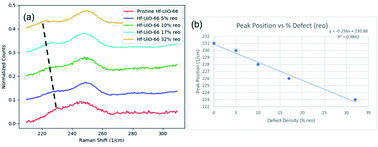Vibrational spectroscopy investigation of defects in Zr- and Hf-UiO-66†
Abstract
Defect engineering in metal–organic framework compounds has allowed for improvements in catalysis-based functionalities, gas sensing, and gas storage. Metal–organic framework UiO-66 compounds with Zr- and Hf-based metal secondary building units were studied with Raman and infrared vibrational spectroscopy. Missing linker and missing cluster defects were engineered into the crystal structure via a modulated synthesis technique. Missing cluster defects in Hf-UiO-66 are first characterized by powder X-ray diffraction (PXRD) whereby two low-angle peaks were fit to extract the relative quantity of reo topology in four defective samples. A monotonic red-shift of the Raman-active Hf–O coordination bond vibration is interpreted as a signature of missing cluster defects, resulting from less-rigid charge-balancing monocarboxylate formate ions replacing the dicarboxylate linker molecule. This signature is hypothesized to be independent of the topology in which the defects appear. Missing linker defects in Zr-UiO-66 are characterized by infrared absorption spectroscopy by the quenching of C–C and C–H vibrational modes confined to the linker molecule. Together, Raman and infrared vibrational spectroscopies coupled with standard characterization techniques are employed to directly probe the nature of defects as well as offer new characterization tools for missing cluster defects in UiO-66.



 Please wait while we load your content...
Please wait while we load your content...